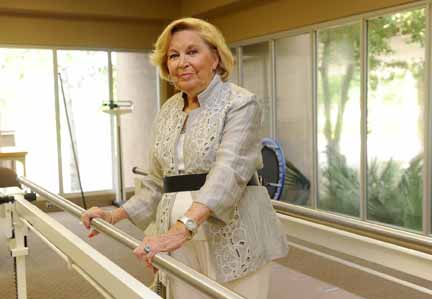At age 91, Elizabeth McIlwain of Jackson has a simple plan for staying young.
“Live today like you did yesterday and live tomorrow like you did today,” she said. “And if something happens to your health, go take care of it.”
McIlwain practices what she preaches, which is why she recenty spent time working out on the exercise equipment at Methodist Rehab’s east campus in Flowood.
She is determined to overcome debilitating back pain that threatened her active lifestyle and put her at risk for life-threatening falls.
“I was having so much trouble … I could hardly walk,” she said. But now she feels “so much better,” she is back to baking tray after tray of her signature tea cakes.
McIlwain suffered from a condition that is common among the elderly, said Dr. Bruce Hirshman, a board certified anesthesiologist and pain management physician at Methodist Pain Management.
“She had inflammation of the facet joints, which are the moveable joints of the spine that connect one vertebra to another,” he said. Studies have suggested that 15 percent of chronic low back pain may be due to facet joint pain.
Many elderly endure the discomfort believing it’s just a consequence of aging. But Dr. Hirshman said even patients in their 80s and 90s can benefit from pain management strategies.
In McIlwain’s case, Dr. Hirshman injected anesthetic and anti-inflammatory medications into the facet joint to block the pain. “He found where the sore spot was and he really fixed it” she said. “Now it just hurts a little bit when I overdo.”
Dr. Hirshman said injection therapies are safe for the elderly unless there are severe medical problems complicating their care. “Occasionally, we can even totally eliminate their pain,” he said. “I just discharged a patient who is 88, and he told me he takes no pain medications now — not even an aspirin.”
Once McIlwain felt better, Dr. Hirshman recommended she start therapy to address another issue that was holding her back. “She had unsteadiness and was falling,” he said.
So he referred her to Susan Geiger, a physical therapist at Methodist Outpatient Rehabilitation who has special training in vestibular rehabilitation and therapies to improve balance.
Geiger said the vestibular system includes parts of the inner ear and brain that help control balance and eye movement. While the system can contribute to balance problems, it wasn’t the culprit in McIlwain’s case.
“She had normal balance problems related to weakness in her trunk and lower extremities,” Geiger said. “When she walked, she couldn’t keep a straight line. She would touch the wall or a person for balance.”
Such unsteadiness can put the elderly at risk for falls, which are a leading cause of injury in the geriatric population. “Think of all the bad problems you can have from falls — broken bones and head injuries,” Geiger said.
To better McIlwain’s balance, Geiger put her on a regimen to improve her strength, endurance and agility. “And I haven’t had a fall since seeing Susan,” McIlwain said.
Hirshman and Geiger said McIlwain’s determination to get better played a major role in her recovery.
“She does not take her age as an excuse to sit down and do nothing,” Geiger said. “She wants to have quality of life all the way through. If you’re motivated, you’re more likely to improve.”
McIlwain said her advice to others is: Don’t ever let yourself get old. And as long as she’s able, she plans to live as independently as
possible.
“I may be 91,” she said, “but I don’t feel it.”

